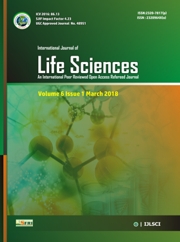RESEARCH ARTICLES
Volume 8 |Issue 1| January-February 2020 First published: 30 February 2020
Review of terrestrial auroras (Aurora australis) and nonterrestrial auroras.
Dr (Ms) Swaroopa Rani N. Gupta
Department of Chemistry, Brijlal Biyani Science College Amravati, Maharashtra, India
Abstract
Keywords: Aurora, Auroral zones, Van Allen radiation belts, Aurora Australis, Jupiter aurora, Saturn's aurora
Editor: Dr.Arvind Chavhan
Cite this article as:
Gupta Swaroopa Rani N. Review of terrestrial auroras (Aurora australis) and non-terrestrial auroras, Int. Res. Journal of Science & Engineering, 2020, Volume 8 Issue 1: 24-34.
References
1. "University of Minnesota Style Manual". .umn.edu. 18 July 2007. Archived from the original on 22 July 2010. Retrieved 5 August 2010.
2. NASA/Johnson Space Center/Earth Sciences and Image Analysis Laboratory https://www.britannica.com/science/ionosphereand-magnetosphere?oasmId=75797
3. https://en.wikipedia.org/wiki/Aurora#/media/Fi le:Aurora_australis_20050911.jpg
4. https://en.wikipedia.org/wiki/Aurora#/media/Fi le:Aurora_Australis_From_ISS.JPG
5. https://en.wikipedia.org/wiki/Aurora#/media/Fi le:DEaurora.gif
6. https://upload.wikimedia.org/wikipedia/common s/0/07/Aurore_australe_-_Aurora_australis.jpg
7. https://en.wikipedia.org/wiki/Aurora#/media/Fi le:Aurora_australis_panorama.jpg
8. https://en.wikipedia.org/wiki/Aurora#/media/Fi le:Aurora_australis_ISS.jpg
9. https://en.wikipedia.org/wiki/Aurora#/media/Fi le:Jupiter.Aurora.HST.UV.jpg.
10. https://en.wikipedia.org/wiki/Aurora#/media/Fi le:Saturns_Northern_Aurora_still.jpg
11. ESA Portal – Mars Express discovers auroras on Mars". Esa.int. 11 August 2004. Retrieved 5 August 2010.
12. Mars Express Finds Auroras on Mars". Universe Today. 18 February 2006. Retrieved 5 August 2010.
13. O'Neill, Ian (29 July 2015). "Monstrous Aurora Detected Beyond our Solar System". news.discovery.com. Discovery. Retrieved 29 July 2015.
14. Q. Choi, Charles (29 July 2015). "First Alien Auroras Found, Are 1 Million Times Brighter Than Any On Earth". space.com. Retrieved 29 July 2015.
15. Stewart, Balfour (1860–1862). "On the Great Magnetic Disturbance of 28 August to 7 September 1859, as Recorded by Photography at the Kew Observatory". Proceedings of the Royal Society of London. 11: 407– 10. doi:10.1098/rspl.1860.0086. JSTOR 111936.
16. Green, J; Boardsen, S; Odenwald, S; Humble, J; Pazamickas, K (2006). "Eyewitness reports of the great auroral storm of 1859". Advances in Space Research. 38 (2): 145– 54. Bibcode:2006AdSpR..38..145G. doi:10.1016/j.asr. 2005.12.021.
17. The British Colonist, Vol. 2 No. 56, 19 October 1859, p. 1, accessed online at British Colonist. Ca Archived 31 August 2009 at the Wayback Machine., on 19 February 2009.
18. Frost, Natasha (2017-10-04). "1770 Kyoto Diary". Atlas Obscura. Retrieved 2017-10-13.
19. Inclined zenith aurora over Kyoto on 17 September 1770: Graphical evidence of extreme magnetic storm". AGU Publications. 2017-09-17. Retrieved 2017-10-13.

